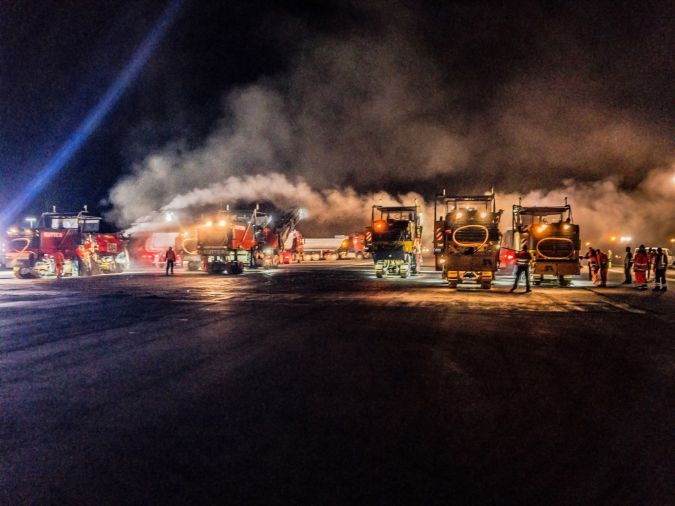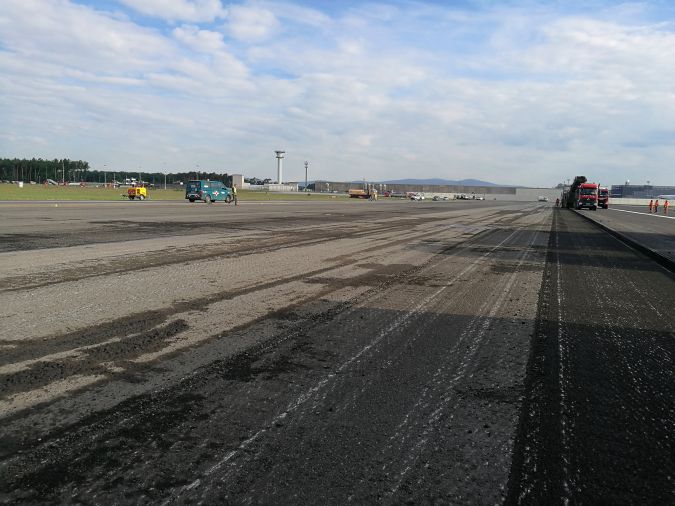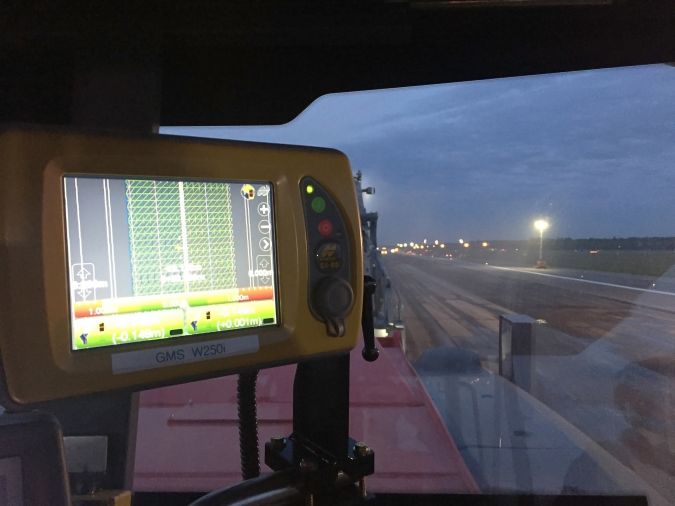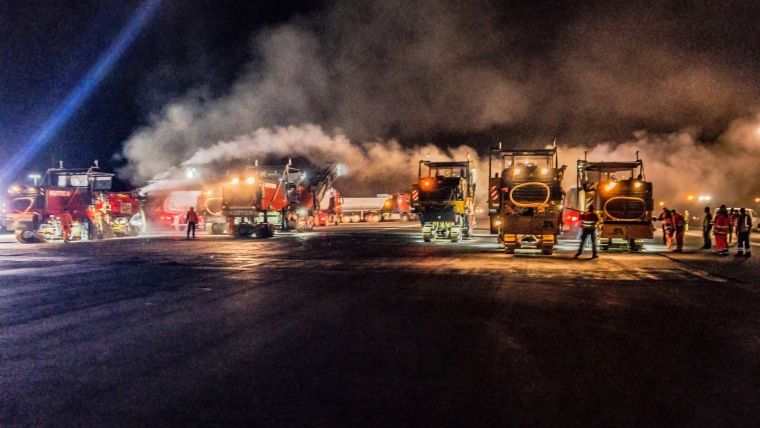Resurfacing Roads or Runways
How Geomatics Smooths out Inefficiencies
One of the runways needed to be resurfaced at Frankfurt Airport in Germany. For an airport, that means serious disruption on many fronts. Frankfurt Airport was therefore interested in cooperating with Topcon to develop a system that would speed up the whole process. The resulting surveying and machine control solution automates most of the data collection, data feeds and measurements – including the as-built data – involved in resurfacing projects. The technology substantially reduces the downtime involved in road or runway renovation activities.
The world population is expected to rise from 7.5 billion today to 9.7 billion by 2050. In view of this population increase and the exponential growth in the number of vehicles, as well as a lack of historic investment in existing and new road networks, there are significant reasons to improve infrastructure across the globe. Therefore, the infrastructure construction industry is under pressure to find innovative, cost-effective ways of working, to limit the amount of time roads are closed, to improve safety for road workers and to make road networks more efficient. Resurfacing is an effective solution for maintaining existing roads, but traditional methods can be both expensive and time-consuming. All of the above considerations hold true for airport runways too: the more passengers and freight an airport handles, the more intensively its runways are used and the more maintenance is needed.
One of the biggest time drains on projects is that roads or runways have to be closed for surveys to be carried out. Current data collection methods involve a surveying team measuring a point around every 15 metres, which does not produce a high data density. Additionally, having such a low point density makes it difficult to smooth out the cross slope and main axis slope. Technology to support automation of mass data collection is key to speeding up these processes, which is why Frankfurt Airport and Topcon teamed up for the renovation of Runway West.

Automated surfacing
Just as with roads, in the case of airport runways it is essential that renovation work can be completed quickly and efficiently, causing as little air traffic disruption as possible. As Europe’s third largest airport, Frankfurt Airport manages over 60 million passengers per year, 50% of which depart from Runway West which was in need of resurfacing. With the airstrip being in such high demand, closing it for maintenance presented an operational challenge. Any work therefore needed to be carried out quickly, without errors. Moreover, due to the high level of on-site security, every person, every truck and all materials had to go through ‘customs’ each time they entered or left the job site.
The project required six milling machines and the associated material-moving trucks to work in parallel at the same time on different parts of the project. This created high traffic on the site and made it impossible to manage machine control via optical instruments. Additionally, the project had to be carried out in just 120 hours; this limited time window would not allow time to set up and move the optical instruments according to the progress of the milling workflow.
With all this in mind, Frankfurt Airport and Topcon developed a system called SmoothRide, encompassing seven steps: surface scanning, planning of new design, milling, control scan of surface changes, paving, compaction, and control scan of the as-built situation. The first stage involves mobile mapping using vehicles that scan at speeds of up to 80km per hour, delivering an accurate depiction of the runway surface. The scanning process results in the creation of a precise map of the entire surface at normal highway speeds. Data is collected every 20cm in the initial survey and therefore provides high-density, accurate data. This process ensures all imperfections in the old runway surface are recorded. The data is utilised in the paving and compacting process to vary the levels of the asphalt required in order to create an evenly flat surface. Control at the project site enables the results to be implemented in real time, meaning that the paving and/or milling can be carried out on the same day that the scans were collected.

Utilising the same job files
The next step is to create a design that meets the necessary specifications. Topcon’s Magnet Office software enables the millions of data points to be managed and optimised. Following this, a transfer is carried out into the ‘Resurfacing’ module, which has features to meet the smoothness and cross slope requirements while adhering to any minimum or maximum thickness specified for the project. The design is then sent directly to the machines, allowing milling and paving to commence immediately.
While traditional surveying methods use 2D machine control, the SmoothRide solution is equipped with 3D machine control. The milling machine’s position is determined by GPS and the height difference for milling is measured by sonic sensors and internal machine sensors. This means that the machine controls the milling depth at every position with millimetre accuracy. Furthermore, automated variable depth milling enables milling to be carried out to precisely the specified depth, allowing for mill-to-fill optimisation and a smooth surface for the paver to follow. By managing material usage, a uniform thickness of paving is achieved, improving accuracy and allowing the job to be completed in one go, thus saving time and reducing cost overrun. With a 14cm milling depth at Frankfurt Airport, it was essential that 3D machine control was carried out. The 3D model allowed accurate measurements to be transferred to a screen in the cabs of the milling machines as guidance for drivers about the exact amount of material to remove. Providing drivers with this level of detail removed the potential for human error and helped to ensure a smooth surface.

After the paver has spread out the asphalt, the compactor compacts the final layer. This is important to optimise the quality and lifetime of the final surface. Utilisation of the same job files generated by the milling and paving machines means that operators know exactly when and where to compact, aided by advanced heat sensors. This prevents over-compacting and therefore increases the efficiency of the process. Whilst compaction processes are active, rollers collect as-built data on the built surface and additional measurements are not required. Essentially, this technology allows for a continuous representation of reality.
Result
The Frankfurt Airport project to resurface 45,000m2 of runway was completed in just five days. Traditional work processes would have taken three weeks longer and would have cost 20% more. The runway is also ultra-smooth, which is not only more comfortable for crews and passengers, but also reduces wear and tear on aircraft, increasing the useful life and reducing repair costs. Topcon now uses SmoothRide successfully in renovation processes within all relevant key infrastructure projects, whether for runways or roads.

Value staying current with geomatics?
Stay on the map with our expertly curated newsletters.
We provide educational insights, industry updates, and inspiring stories to help you learn, grow, and reach your full potential in your field. Don't miss out - subscribe today and ensure you're always informed, educated, and inspired.
Choose your newsletter(s)
























